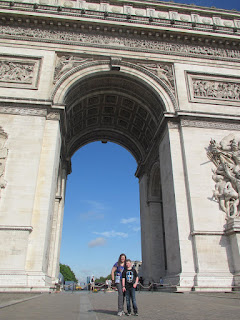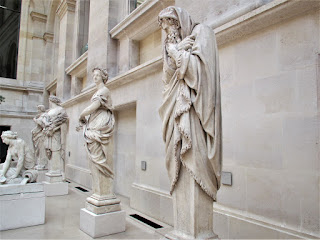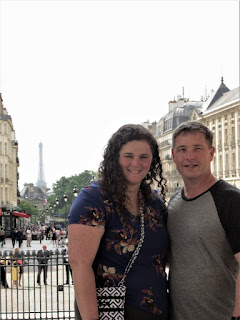
This is my third trip touring Paris. The first was in 1993 on my way to Israel, where we had a very short stop and had time to run and a see a site or two. The second was in 2001, on a port visit to Cannes, we rented a car and drove to Normandy through Paris and saw a little more of the city. But this trip has provided the most opportunity to spend time at each site. This morning we visited the Arc de Triomphe. Landon was (SIR) sick-in-room, and wasn't able to see today's sites, but hopefully he'll be able to travel with us tomorrow.

Construction of the Arc was directed by Napoleon in the early 1800's. He died before it was finished. It's purpose was to commemorate those lost in the French Revolution and the Napoleonic Wars.

It sits at the juncture of 12 radiating avenues, at the western end of the Champs-Elysees, the street named after the Elysian Fields of Greek mythology.

It's design was inspired by the Arc of Titus, in Rome.

At the base, is the French Tomb of the Unknown Soldier, laid to rest there after WWI. In modern times, the Arc is used to commemorate military victories, and has included both French and enemy parades, as Hitler himself rode into Paris around the monument (after the laying of the Tomb of the Unknown Soldier in 1921 in the middle, no one marches through the center anymore). There is a flame of remembrance at the base, re-lit every evening. At far end of this picture, you can just make out Le Grande Arche in the distance, the more modern-looking Arche built to celebrate the humanities in contrast to the military victories commemorated by the Arc de Triomphe. (We didn't visit Le Grande Arche).

After the Arc, we made our way to the Louvre Museum.

The world's largest museum of antiquities, the Louvre was built on the site of a palace constructed in the 12th and 13th centuries.

The Louvre Pyramids greet you upon entrance.

The museum contains more than 380,000 objects of antiquity, in its more than half million square feet of indoor exhibition floor space.

The pyramid construction is unique to view, but has caused some argument by some in Paris as being 'too modern' amongst the history of the Louvre.

From the Place du Carrousel (Louvre courtyard), you can see the Arc de Trioumphe du Carrousel (a smaller arc nearby) and the Eiffel Tower in the distance.

Walking around the palace courtyard outside the Louvre entrance provides an adequate appreciated of architecture from the time period of many of the pieces inside the museum.

The smaller Arc de Triomphe du Carrousel, with Eiffel Tower visible in the distance.

To adequately appreciate the exhibits in the Louvre, you need about a week to view it. We had half a day, so as we strolled around the massive museum, we took some pictures of exhibits that interested us, and will have to research later the significance of each. We'll add comments to these pics later as we have time.


Reminded me of Lady Liberty.


Grayson posing in front of Napoleon Bonaparte.

Hercules depicted in a battle against Achelous transformed into a serpent.

Who knew they already had a statue of me in the Louvre!

Pulling a spearhead from his thigh.

Assyrian human-headed winged bull from the Palace of Saargon II, 8th century BC, Mesopotamia, recovered from near Mosul in present-day Iraq.


One of the 36 columns which held up the audience hall in the palace of Persian King Darius I, from the 5th century BC.

King Darius I timeframe.










Mona Lisa


Is he holding a cell phone?


Venus de Milo






































































